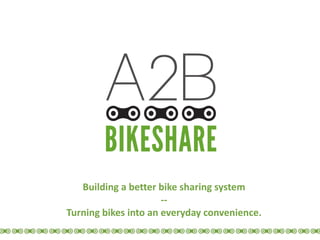Pitch deck 2 14-13 cevc
- 1. Building a better bike sharing system -- Turning bikes into an everyday convenience.
- 2. What is Bike Sharing? Think ZipCar For Bikes
- 3. Benefits of Bike Sharing ŌĆó Solves the last mile problem ŌĆó Improves local economies ŌĆó Lowers car usage, CO2 emissions, and congestion
- 4. Why isnŌĆÖt Bike Sharing Everywhere?
- 5. Competition Affordable ’ā╝ ’ā╝ ’ā╝ Structured & Secure ’ā╝ ’ā╝ ’ā╝ Proven ’ā╝ ’ā╝ ’ā╝ soon Great User Experience ’ā╝
- 6. The Solution Smart Bikes ŌĆō Dumb Racks
- 7. How it Works - Demo
- 8. Traction Provisional Patents Google Test Prototype Michigan LLC Company Started (Dec. 2011)
- 9. Revenue Model Initial Sale Licensing Fee Proximity Advertisements Shops & Restaurants
- 10. 5 Year Forecast Year 2013 2014 2015 2016 2017 System Fleet 15 215 900 1500 3000 Sales 22,500 400,000 1,370,000 12,00,000 30,00,000 Licensing 4,500 64,500 270,000 450,000 900,000 Adds 3,000 43,000 180,000 300,000 600,000 Total Revenue 30,000 507,500 1,820,000 1,950,000 4,500,000 COGS 72,500 300,000 822,000 660,000 1,500,000 SGA 0 150,000 340,000 560,000 1,200,000 EBT -42,500 57,500 658,000 730,000 1,800,000
- 11. Market Size 500+ US cities with public transit $56 billon industry 240 US cities ŌĆśbike friendlyŌĆÖ $469 Million 100 US cities >100k population $425 Million
- 12. Potential Customers Secondary Customers ŌĆó Universities ŌĆó Corporate Campuses
- 13. Partners Partners Needed ŌĆó Mechanical Hardware Manufacturer ŌĆó Electronic Hardware Manufacturer ŌĆó Advertisement Agency
- 14. Team Keith Porter Ansgar Strother Co-Founder Co-Founder Brianna Schwartz Renjay Lui Art Director Lead Software Architect Kevin Chyn Carl Vitullo Software Developer Software Developer Looking for an: Looking for a: Additional Market Analyst or Programmer System Analyst
- 15. Board of Advisors Parrish Bergquist M. Urban Planning, U of M - Bike Sharing Advice James Goebel COO, Menlo Innovations - Business Advice Tim Potter Manager, MSU Bikes - Bike Advice
- 16. Next Steps Large System Sale Small System Test Mfg. Ready - $50k Finalize Designs
- 17. How You Can Help ŌĆó Grant funding ŌĆó Connections ŌĆó Visit www.a2bbikeshare.com and like us on Facebook
Editor's Notes
- Transportation means connecting short distances between walking and bus/car traffic40% of people spend money when using one of our rental bikesMany rides actually take the place of car trips, reducing CO2 emissions
- Went out and talked to potential customers to learn why we donŌĆÖt have bike sharingDiscovered that it isnŌĆÖt that they donŌĆÖt want it, itŌĆÖs that the solutions available donŌĆÖt fit their needs
- Researched our competitors and discovered four key differentiating factors, price, security, experience, and usabilityExisting ŌĆśsuccessfulŌĆÖ systems based on rack based architecture are proven and secure but cost 4-6k per bikeStartups have formed to cut the costs significantly but do so by removing the rack, this seriously hinders bike security and system structure
- So through the iterative process of talking with our customers, we discovered the best way to maximize all four characteristics:Smart bikes, dumb racks.By placing the rental equipment on the bike we lower the costs significantly.By including a bike rack (albeit dumb) we ensure system reliability and security.
- So now IŌĆÖll walk you through a bit of the result of that iterative process, the prototype you see here.So you walk up to the bike, tap on the touch screen, unlock the lock, ride around, drop it off, lock it up, this is all powered and sustained by the solar panel on the backNow Ansgar will tell you about how we turn this customer need into a strong business.
- Our cash flows model makes us profitable at our first sale because we would be charging partially upfront and the remainder upon delivery.Change side to chart on revenue Software Maintenance FeePriced RoundAdd a revenue model slide
- Our cash flows model makes us profitable at our first sale because we would be charging partially upfront and the remainder upon delivery.Change side to chart on revenue Software Maintenance FeePriced RoundAdd a revenue model slide
- 100 US cities >100k population$250M/yr sales revenue$125M/yr operating revenue$ 50M/yr Ad Revenue240 US cities ŌĆśbike friendlyŌĆÖ$276M/yr sales revenue$138M/yr operating revenue$ 55M/yr Ad Revenue
- This model of selling has already been proven in dozens of times across the US and worldClean up the slide
- Partial contracting
- Talk about how much we already spentConvertible debt offering
- Convertible Debt


















